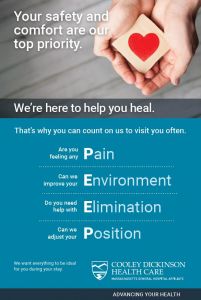June 6, 2019
June 6, 2019
 Typically, hospitalized patients ring their call bells for 4 reasons:
Typically, hospitalized patients ring their call bells for 4 reasons:
• pain/discomfort;
• environment/they need something in their room,
• elimination/help getting to the bathroom, and
• position/they need help getting in a more comfortable position.
Cooley Dickinson nurses are trying to get ahead of the call bells – and help patients feel safer and more comfortable – by implementing a new purposeful rounding program.
“This is about proactively looking at what the patient needs,” said Chief Nursing Officer Angela Belmont, of the new purposeful rounding program. “We are really excited to launch this program at Cooley Dickinson Hospital.”

Being Intentional
According to Nursing Director, Critical Care Ann LeBrun the nurses are already in a patient’s room whether it is to answer a call bell or to check on them.
“By focusing on 4 key areas – pain, environment, elimination, and position or PEEP – we help patients feel more comfortable and reassured. At the same time, we also get a status on each patient, which was something we had been doing, but it wasn’t as intentional.”
LeBrun says that with purposeful rounding, if someone needs to be re-positioned in bed, “we can help them and give them their medication during that same visit. Before this program, we might have given someone their medication, and then 15 minutes later the patient rang the call bell for assistance using the bathroom.
“This is just a better, more efficient way to provide care,” Lebrun added.
Sorry We Missed You
When it comes time for the nurse to round, there are times when the patient has left their room for an imaging exam or another reason. When that happens, the nurse will leave a card on the patient’s bed to let them know the nurse has stopped by.
“This is a way to reassure the patient we are here for them, and that we will be back to check on them soon. If they have questions, there is space on the back of the card for them to jot down those questions. And once the nurse stops by again, the nurse can review those questions with the patient.”
The card lists questions that may help the patient think about what they may want to ask the nurse. For example, for pain, we ask, do you feel any discomfort? If so, describe.
Next Steps
While currently a pilot program on Cooley Dickinson’s Telemetry and West 4 patient care units, Lebrun expects purposeful rounding to happen on other units as appropriate in the coming months.
Best Practice Care
The Institute of Healthcare Improvement (IHI) endorsed timely hourly rounding as the best way to reduce call lights and fall injuries, and increase both quality of care and patient satisfaction.
To see how the Cleveland Clinic provides bedside rounding to their patients, watch this video.

